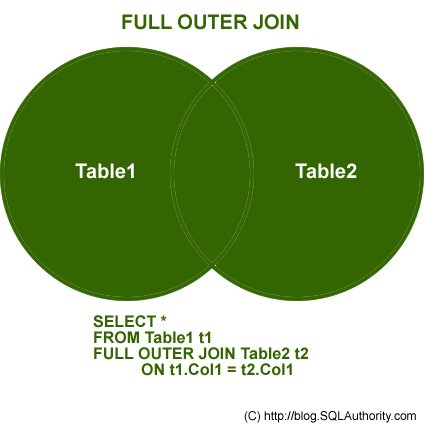Winner of Best BI Software for SQL. Move Forward With Confidence. Get the Most out of Your Data. Watch the Free Tableau Video Demo! Connecting With The Data Community.

SQL FULL OUTER JOIN Keyword. The FULL OUTER JOIN keyword returns all records when there is a match in left (table1) or right (table2) table records. Note: FULL OUTER JOIN can potentially return very large result-sets!
Tip: FULL OUTER JOIN and FULL JOIN are the same. In theory, a full outer join is the combination of a left join and a right join. Syntax diagram - FULL OUTER JOIN.
Let’s combine the same two tables using a full join. Summary: in this tutorial, you will learn how to use the SQL Server FULL OUTER JOIN to query data from two or more tables. Introduction to SQL Server full outer join.
Country AS CustomerCountry, S. CompanyName FROM Customer C FULL JOIN Supplier S ON C. A full outer join would give us all records from both tables, whether or not they have a match in the other table, with NULLs on both sides where there is no match. SQL full outer join returns: all rows in the left table table_A. For each row in the Ttable, the full outer join compares it with every row in the Ttable. If rows from both tables meet the join _condition, the full outer join includes columns of both rows in the result set. We say that the row in Ttable matches with the row in the Ttable in this case.
Oracle FULL OUTER JOIN : A full outer join is such a join that performs a join between two tables that returns the of an INNER join as well as the of a left and right outer join. This tutorial explains FULL OUTER JOIN and uses in Oracle. A full outer join , or full join , which is not supported by the popular MySQL database management system, combines and returns all data from two or more tables, regardless of whether there is shared information. Think of a full join as simply duplicating all the specified information, but in one table, rather than multiple tables.
An outer join will combine the selected columns from the two joined rowsets for every combination of rows that satisfy the join predicate and will add the rows that are not having a match for the specified join side. Conceptually, a full outer join combines the effect of applying both left and right outer joins. Where rows in the FULL OUTER JOINed tables do not match, the result set will have NULL values for every column of the table that lacks a matching row. The rows for which there is no matching row on right side, the result-set will contain null.
In the previous examples, we explored the SQL Left Outer Join , and the SQL Right Outer Join with different examples. We can do a Union of the result of both SQL Left Outer Join and SQL Right Outer Join. LEFT JOIN is also known as LEFT OUTER JOIN. The joined table will contain all records from both the tables and fill in NULLs for missing matches on either side. The basic syntax of a FULL JOIN is as follows − SELECT table1.
The OUTER keyword is optional. The full outer join combines the of both left join and right join. If the rows in the joined table do not match, the full outer join sets NULL values for every column of the table that lacks a matching row. SQL Joins - Left Join , Right Join , Inner Join and Full Join.
In some databases, the FULL OUTER JOIN keywords are replaced with FULL JOIN. Today’s SQL article is all about Full Outer Join. Before moving ahead just want to say that in order to better understand the concept of full outer Join please read my last two SQL tutorial article on right and left outer join. What Is the Difference Between a Join and UNION?
Joins and Unions can be used to combine data from one or more tables. The difference lies in how the data is combined. In simple terms, joins combine data into new columns.
If two tables are joined together, then the data from the first table is shown in one set of column alongside the second. All the Unmatched rows will be filled with NULL Values. The SQL Server Full Outer join can also be called as Full Join.
So it is optional to use the Outer Keyword. It add all the matching rows from both the tables. If there is no match in both the table, it return null value for the missing cell. Outer Join : An outer join in SQL is a specific kind of query construction that deliberately allows for a wider array of. The process of building specific queries in SQL to get database is a highly technical one, and an outer join is an example of a type of detail learned and utilized by database researchers.
There are legitimate cases where duplicate. It is commonly used in conjunction with aggregations to understand.
Geen opmerkingen:
Een reactie posten
Opmerking: Alleen leden van deze blog kunnen een reactie posten.